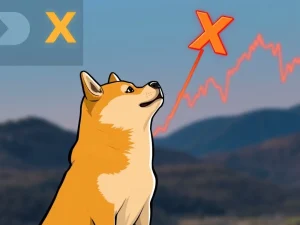Bitcoin Liquidation Warning: Explosive $948M Short Squeeze Looms Above $119,000

The cryptocurrency world is abuzz with anticipation as Bitcoin’s price hovers near critical thresholds, hinting at potential seismic shifts. New data reveals that if Bitcoin surges past $119,000, a staggering $948 million in short positions could face Bitcoin liquidation on centralized exchanges (CEXs). This isn’t just a number; it’s a potential catalyst for extreme market volatility, impacting traders and investors globally. Understanding these key levels is paramount for anyone navigating the dynamic crypto landscape.
Understanding the Impending Bitcoin Liquidation Threat
What exactly happens when millions in positions get liquidated? Liquidation occurs when a trader’s leveraged position is forcibly closed by an exchange due to insufficient margin to cover potential losses. It’s a high-stakes game, and recent data from Coinglass, analyzed by BlockBeats, paints a vivid picture of the current risks.
The report highlights two pivotal price points for Bitcoin:
- Above $119,000: Should Bitcoin’s price cross this mark, an estimated $948 million worth of short positions on major CEXs could be liquidated. Short liquidations typically fuel upward price momentum as traders are forced to buy back assets to close their positions.
- Below $116,000: Conversely, a drop below this level could trigger approximately $588 million in long liquidations. Long liquidations often exacerbate downward price pressure as forced selling occurs.
These figures, while substantial, represent ‘relative clusters of liquidity’ rather than exact contract values. They indicate areas where market reactions are likely to be pronounced due to concentrated leverage. The concept of ‘liquidation bars’ on Coinglass charts visually represents these zones, with higher bars signaling greater potential impact.
Why is Bitcoin Price Action So Volatile Around These Levels?
The Bitcoin price is notoriously sensitive to leveraged trading, and these specific levels are no exception. Leveraged trading allows participants to open positions larger than their initial capital, amplifying both potential gains and losses. While it offers immense opportunities, it also introduces significant systemic risk.
When price approaches these liquidation thresholds, several dynamics come into play:
- Forced Buying/Selling: As positions hit their liquidation price, exchanges automatically close them. For shorts, this means buying Bitcoin; for longs, it means selling. This forced activity creates a cascade, pushing the price further in the direction of the initial move.
- Slippage and Market Depth: Large liquidation orders can overwhelm market depth, leading to slippage where orders are filled at worse prices, further accelerating the move.
- Psychological Impact: The knowledge of massive liquidation walls can also influence trader behavior, leading to anticipatory moves or panic selling/buying, further contributing to volatility.
- Algorithmic Trading: Many trading firms and algorithms are programmed to react to these liquidity clusters, potentially exacerbating the speed and magnitude of price swings.
Navigating the Crypto Market Analysis: What Does This Data Mean for Traders?
For anyone engaged in crypto market analysis, understanding liquidation data is a crucial, though not singular, piece of the puzzle. This information offers insights into potential market flashpoints and areas of concentrated risk or opportunity.
Here’s what traders should consider:
- Risk Management: If you hold leveraged positions, these levels serve as critical warning signs. Re-evaluate your stop-loss orders and margin levels.
- Volatility Expectation: Be prepared for heightened volatility around $119,000 and $116,000. Price action could be swift and unforgiving.
- Confirmation is Key: While liquidation data is powerful, it should be used in conjunction with other technical and fundamental analysis tools. Don’t rely solely on one metric.
- Opportunity for Spot Traders: Even spot traders, who don’t use leverage, can be affected. Large liquidation events can create rapid price swings, offering opportunities for quick entries or exits, but also increasing risk.
The Role of CEX Liquidations in Market Dynamics
Centralized exchanges (CEXs) are the primary venues for CEX liquidations due to their role in facilitating leveraged trading. These platforms manage users’ margin accounts and are responsible for enforcing liquidation protocols to prevent users’ balances from falling into negative territory, which would result in losses for the exchange.
The mechanics involve:
- Margin Calls: As a position moves against a trader, they may receive a margin call, requesting additional funds to maintain their position.
- Automatic Liquidation: If the margin is not topped up, or the price reaches the liquidation threshold, the exchange automatically closes the position to protect itself and the solvency of the market.
- Impact on Market Structure: Large-scale liquidations on CEXs can create ‘liquidation cascades,’ where one liquidation triggers another, leading to rapid price movements. This phenomenon is a significant factor in Bitcoin’s historical flash crashes and rapid rallies. The transparency of Coinglass data helps shed light on these potential cascade points, allowing for more informed market observation.
Strategies for Managing Leveraged Trading Risks
While the allure of amplified gains through leveraged trading is strong, the risks, especially around critical liquidation levels, are equally significant. Prudent risk management is not just advisable; it’s essential for survival in the volatile crypto markets.
Consider these strategies:
- Position Sizing: Never over-leverage. Determine a position size that aligns with your risk tolerance and capital. A smaller position means a larger buffer before liquidation.
- Stop-Loss Orders: Always use stop-loss orders. These automatically close your position if the price moves against you to a predefined level, limiting potential losses and preventing liquidation.
- Take-Profit Orders: Just as important as stop-losses, take-profit orders help secure gains and prevent emotional decision-making.
- Monitor Funding Rates: High funding rates in perpetual futures markets can indicate an overcrowded trade, increasing the likelihood of a squeeze or liquidation event.
- Stay Informed: Keep an eye on market news, on-chain data, and, yes, liquidation maps. This holistic approach provides a clearer picture of market sentiment and potential catalysts.
The potential for a nearly billion-dollar Bitcoin liquidation event above $119,000 serves as a powerful reminder of the inherent volatility and interconnectedness of the cryptocurrency market. While such events can be daunting, they also underscore the importance of data-driven decision-making and robust risk management. As Bitcoin continues its journey, monitoring these critical price levels and understanding the mechanics of leveraged trading will be paramount for traders aiming to navigate the market successfully. Stay vigilant, stay informed, and always prioritize capital preservation in this thrilling, yet unpredictable, digital frontier.
FAQs
Q1: What is Bitcoin liquidation?
A1: Bitcoin liquidation occurs when a trader’s leveraged position in Bitcoin is automatically closed by an exchange because the market price has moved against their trade to a point where their margin collateral is no longer sufficient to cover potential losses. This is done to prevent the trader’s balance from going negative.
Q2: How do Bitcoin price movements above $119,000 trigger short liquidations?
A2: If Bitcoin’s price rises above $119,000, it means short sellers (who profit from price declines) are losing money on their positions. When the price reaches their liquidation threshold, their short positions are forcibly bought back by the exchange, creating buying pressure that can further propel the price upward in a “short squeeze.”
Q3: What is the significance of the $116,000 level for Bitcoin?
A3: Conversely, the $116,000 level is identified as a significant point for long liquidations. If Bitcoin’s price drops below this threshold, long positions (who profit from price increases) could face forced selling, potentially accelerating a downward price trend.
Q4: How reliable is Coinglass data for crypto market analysis?
A4: Coinglass data provides valuable insights into aggregated liquidation levels across various centralized exchanges, offering a snapshot of potential liquidity clusters. While useful for identifying high-impact price points, it represents “relative clusters of liquidity” and should be used in conjunction with other technical and fundamental analysis for a comprehensive crypto market analysis.
Q5: What are CEXs, and why are they relevant to liquidations?
A5: CEXs (Centralized Exchanges) are cryptocurrency trading platforms that facilitate transactions, including leveraged trading. They are relevant to liquidations because they manage users’ margin accounts and enforce the liquidation process to ensure market stability and prevent excessive losses for traders and the exchange itself.
Q6: What can traders do to manage risks associated with leveraged trading?
A6: Traders engaging in leveraged trading should prioritize risk management by using appropriate position sizing, setting strict stop-loss orders to limit potential losses, and taking profits at predefined levels. Continuously monitoring market conditions, funding rates, and liquidation maps also helps in making informed decisions.










